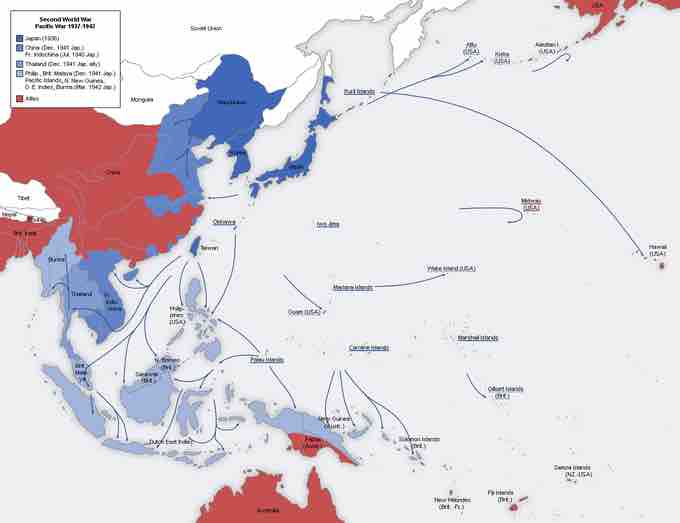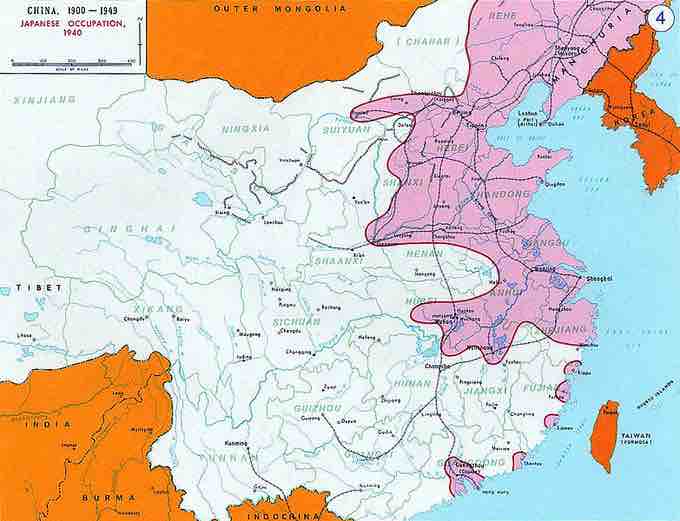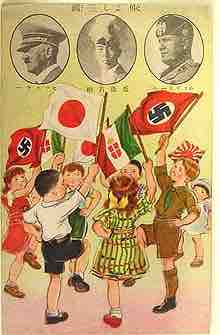MANCHURIA
In the 1920s and 1930s, the Japanese Empire's main economic problem was the lack of sufficient raw materials. Japan needed to import raw materials such as iron, rubber, and oil to maintain strong economic growth. The Japanese felt that acquiring resource-rich territories would establish economic self-sufficiency and independence, and they also hoped to jump-start the nation's economy in the midst of the Great Depression. As a result, Japan set its sights on East Asia, specifically Manchuria with its many resources.
In the 1920s and 1930s, the Japanese Empire's main economic problem was the lack of sufficient raw materials. Japan needed to import raw materials such as iron, rubber, and oil to maintain strong economic growth. The Japanese felt that acquiring resource-rich territories would establish economic self-sufficiency and independence, and they also hoped to jump-start the nation's economy in the midst of the Great Depression. As a result, Japan set its sights on East Asia, specifically Manchuria with its many resources.
On September 18, 1931, in what is known as the Mukden Incident, Lt. Suemori Kawamoto detonated a small quantity of dynamite close to a railway line owned by Japan's South Manchuria Railway near Mukden (now Shenyang). The explosion was so weak that it failed to destroy the track and a train passed over it minutes later, but the Imperial Japanese Army accused Chinese dissidents of the act and responded with a full invasion. A day later, Japan invaded Manchuria. It claimed that the invasion was a liberation of the Manchus from the Chinese, although the majority of the population were Han Chinese as a result of the large scale settlement of Chinese in Manchuria in the 19th century. A puppet regime called Manchukuo was established with little resistance. Jehol, a Chinese territory bordering Manchuria, was taken in 1933. Japan had withdrawn from the League of Nations earlier that year and the events led to no specific actions from the international community.
In 1936, Japan also created a Mongolian puppet state in Inner Mongolia named Mengjiang, which was also predominantly Chinese as a result of recent Han immigration to the area.
CHINA
In 1937, Japan invaded China, starting what was essentially a three-way war between Japan, Mao Zedong's communists, and Chiang Kai-shek's nationalists. The invasion began what would become known as the Second Sino-Japanese War, which after the Japanese attack on Pearl Harbor in 1941 would merge into the greater conflict of World War II as a major front of what is broadly known as the Pacific War.
Building on the hard won victory in Shanghai, the Japanese army captured the Chinese nationalist capital city of Nanjing (Nanking) and Northern Shanxi by the end of 1937, in campaigns involving approximately 350,000 Japanese soldiers and considerably more Chinese. After the fall of Nanking on December 13, what would become known as the Nanking Massacre began and lasted over the period of the next six weeks. Historians estimate up to 300,000 Chinese civilians and disarmed combatants were mass murdered in the process. Because of the widespread systematic use of rape, the events are also known as the "Rape of Nanking." Historians estimate that, additionally to children and the elderly, around 20,000 women were raped. Records of eyewitnesses demonstrate a massive scale of brutal violence. Until today, some Japanese deny the atrocities ever occurred.
The Second Sino-Japanese War was the largest Asian war in the 20th century. It accounted for the majority of civilian and military casualties in the Pacific War, with anywhere between 10 and 25 million Chinese civilians and over 4 million Chinese and Japanese military personnel dying from war-related violence, famine, and other causes. By the end of the Pacific War, Japan had conquered much of the Far East, including Hong Kong, Vietnam, Cambodia, Myanmar, the Philippines, Indonesia, part of New Guinea and some islands of the Pacific Ocean.

A map of the Japanese advance from 1937 to 1942.
A map of the Japanese advance from 1937 to 1942.
SOVIET UNION
In 1938, the Japanese 19th Division entered territory claimed by the Soviet Union, leading to the Battle of Lake Khasan. This incursion was founded in the Japanese belief that the Soviet Union misinterpreted the demarcation of the boundary, as stipulated in the Treaty of Peking, between Imperial Russia and Manchu China. On May 11, 1939, in the Nomonhan Incident (Battle of Khalkhin Gol), a Mongolian cavalry unit of some 70 to 90 men entered the disputed area. The Japanese also became involved. Joseph Stalin ordered to develop a plan for a counter-strike against the Japanese, which resulted in massive Japanese losses. On September 15 an armistice was arranged. Nearly two years later, on April 13, 1941, the parties signed a Neutrality Pact, in which the Soviet Union pledged to respect the territorial integrity and inviolability of Manchukuo, while Japan agreed similarly for the Mongolian People's Republic.
In 1938, the Japanese 19th Division entered territory claimed by the Soviet Union, leading to the Battle of Lake Khasan. This incursion was founded in the Japanese belief that the Soviet Union misinterpreted the demarcation of the boundary, as stipulated in the Treaty of Peking, between Imperial Russia and Manchu China. Joseph Stalin ordered a counterstrike, and the use of superior artillery, armor, and air forces nearly annihilated the Japanese forces. On September 15 an armistice was arranged, and two years later, on April 13, 1941, the parties signed aNeutrality Pact, in which the Soviet Union pledged to respect the territorial integrity and inviolability of Manchukuo, while Japan agreed similarly for the Mongolian People's Republic .

Japanese Occupation - Map
Map showing the extent of Japanese control (purple) in 1940.
WORLD WAR II
On September 27, 1940, Imperial Japan signed the Tripartite Pact with Nazi Germany and Fascist Italy, establishing what would become known as the Axis Powers. The pact called for mutual protection and technological and economic cooperation.

Children waving German, Italian, and Japanese flags of 1938.
A Japanese propaganda poster for the Tripartite Pact: "Good friends in three countries". (left Adolf Hitler, center Fumimaro Konoe, right Benito Mussolini)
Facing an oil embargo by the United States as well as dwindling domestic reserves, the Japanese government decided to attack Pearl Harbor, Oahu, Hawaii, on December 7, 1941, leading to significant losses for U.S. navy and air forces. and The objective of the attack was to incapacitate the U.S. long enough for Japan to establish its Southeast Asian empire and defensible buffer zones. The United States entered the European Theatre and Pacific Theater in full force. Four days later, Adolf Hitler of Nazi Germany and Benito Mussolini of Italy declared war on the United States, merging the separate conflicts.
Following Pearl Harbor, the Japanese launched offensives against Allied forces in South East Asia, with simultaneous attacks on Hong Kong, British Malaya and the Philippines. Hong Kong surrendered to the Japanese on December 25th, 1941. The Japanese forced the Allies in Malaya to retreat into Singapore and on February 15, 1942, Singapore fell to the Japanese, causing the largest surrender of British-led military personnel in history. The Japanese military carried out a purge of the Chinese population in Malaya and Singapore, and are believed to have killed tens of thousands of ethnic Chinese. In the Philippines, the Japanese pushed the combined Filipino-American force towards the Bataan peninsula and later the island of Corregidor. January 1942 marked one of the worst defeats suffered by the Americans, leaving over 70,000 American and Filipino prisoners of war in the custody of the Japanese.
The Japanese also seized the key oil production zones of Borneo, Central Java, Malang, Cepu, Sumatra, and Dutch New Guinea of the late Dutch East Indies, defeating the Dutch forces. They also consolidated their lines of supply through capturing key islands of the Pacific, including Guadalcanal.
In May 1942, the Japanese failed to defeat the Allies at the Battle of the Coral Sea, despite numerical superiority, and in June 1942 they lost a four-carrier task force at the Battle of Midway. Midway was a decisive defeat for the Japanese, and proved to be the turning point of the war. In September 1942 they were defeated by Australians in New Guinea at the Battle of Milne Bay. Further defeats by the Allies at Guadalcanal in September 1942 and New Guinea in 1943 put the Empire of Japan on the defensive for the remainder of the war.